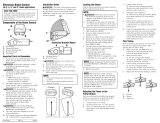
wc_si000301gb.fm
10
Safety Information LTW 20Z
1.2 Machine Description and Intended Use
This machine is a mobile, trailer-mounted light tower. The Wacker Neuson Light
Tower consists of a trailer with a cabinet containing a diesel engine, a fuel tank, a
control panel, and an electric alternator. A telescoping tower with four metal halide
lights is mounted to the top of the cabinet. Dual winches tilt, raise, and lower the
telescoping tower. As the engine runs, the generator converts mechanical energy
into electric power. The metal halide lights run off this power. Receptacle(s) are
also present to power auxiliary loads. The operator uses the control panel to
operate and monitor the machine.
This machine is intended for the illumination of outdoor areas. This machine is also
intended for the purpose of supplying electrical power to connected loads. Refer to
the product specifications for the output voltage and frequency of this Light Tower,
and for the maximum output power limit of this Light Tower.
This machine has been designed and built strictly for the intended use described
above. Using the machine for any other purpose could permanently damage the
machine or seriously injure the operator or other persons in the area. Machine
damage caused by misuse is not covered under warranty.
The following are some examples of misuse:
Connecting a load that has voltage and frequency requirements that are
incompatible with the machine output
Overloading the machine with a device that draws excessive power during
either continuous running or start-up
Operating the machine in a manner that is inconsistent with all federal, state and
local codes and regulations
Using the machine as a ladder, support, or work surface
Using the machine to carry or transport passengers or equipment
Using the machine to tow other machines (unless factory equipped)
Using the machine as a hoist or hanging items from the tower
Operating the machine outside of factory specifications
Operating the machine in a manner inconsistent with all warnings found on the
machine and in the Operator’s Manual
This machine has been designed and built in accordance with the latest global
safety standards. It has been carefully engineered to eliminate hazards as far as
practicable and to increase operator safety through protective guards and labeling.
However, some risks may remain even after protective measures have been taken.
They are called residual risks. On this machine, they may include exposure to:
Heat, noise, exhaust, and carbon monoxide from the engine
Heat from the lights
Ultraviolet radiation from the lights
Fire hazards from improper refueling techniques
Fuel and its fumes
Electric shock and arc flash
Personal injury from improper lifting the trailer tongue




















